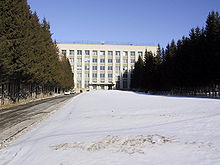Budker Institute for Nuclear Physics
The Budker Institute of Nuclear Physics ( Russian Институт ядерной физики им. Г. И. Будкера СО РАН , English Budker Institute of Nuclear Physics, BINP ) is a research institute for nuclear physics of the Siberian Branch of the Russian Academy of Sciences in Novosibirsk .
history
It was in 1958 as the Institute of Nuclear Physics (Engl. Institute of Nuclear Physics , INP) under the direction of Budker Gersch Izkowitsch founded, the board him as director until his death in 1977. In honor of Budker, the institute was then renamed the Budker Institute for Nuclear Physics . Since then it has been under the direction of Alexander Nikolaevich Skrinsky . BINP has been headed by Pavel Logachev since 2015 .
Research areas

(an electron-electron collider ).
Along with the United Institute for Nuclear Research, BINP is one of the largest in Russia and one of the world's leading research institutes for high-energy physics . It conducts basic research on the structure of matter with the help of large particle accelerators , such as several accelerator systems for the collision of electrons and their antiparticles, the positrons . The electron positron colliders VEPP-2000 and VEPP-4M achieve particle energies of up to 1 GeV and 6 GeV, respectively. The BINP has in the 1960s with the VEP-1 one of the world's first storage rings designed for particle collisions, an Electron-Electron Collider with electron energies of 160 MeV, and with the VEPP-2 the first Electron-positron collider at all , with particle energies of up to 700 MeV.
Components for accelerator systems are also being developed. For example, the electron cooling proposed by Budker for the first time in the mid-1960s , for damping oscillations in particle beams, was first implemented at BINP in the 1970s. The institute later played a key role in the development and construction of the electron cooling system for the SIS-18 at the GSI Helmholtz Center for Heavy Ion Research , the COZY cooler synchrotron at the Jülich Research Center and the Low Energy Ion Ring at CERN .
Further research focuses are plasma physics and controlled nuclear fusion as well as the development of powerful sources for synchrotron radiation , such as free-electron lasers . The BINP is also a training center for around 200 students from the Novosibirsk State University and the Novosibirsk State Technical University . In 2012, the institute employed over 2,800 people, including around 400 scientists and 1,000 employees in the production department for experimental and accelerator systems.
Web links
literature
- Alexander Skrinsky: Accelerator field development at Novosibirsk (history, status, prospects). (PDF; 225 kB) In: Proc. of the 1995 Particle Accelerator Conference (Vol. 1). May 1-5 , 1995, Dallas, USA, ISBN 0-7803-2934-1 , pp. 14-25, doi: 10.1109 / PAC.1995.504558 .
Individual evidence
- ↑ a b c Annual Report 2012. (PDF; 21 MB) Budker Institute of Nuclear Physics, 2013, p. 7 , accessed on June 21, 2016 .
- ↑ a b Alexander Skrinsky: Accelerator field development at Novosibirsk (history, status, prospects). (PDF; 225 kB) In: Proc. of the 1995 Particle Accelerator Conference (Vol. 1). May 1-5 , 1995, Dallas, USA, ISBN 0-7803-2934-1 , pp. 14-25, doi: 10.1109 / PAC.1995.504558 .
- ^ Budker Institute of Nuclear Physics ; accessed on August 16, 2019
- ^ J. Beringer et al .: High-energy collider parameters. (PDF; 90 kB) In: REVIEW OF PARTICLE PHYSICS (Phys. Rev. D). Vol. 86, No. 1, 010001, 2012, pp. 317-321, doi: 10.1103 / PhysRevD.86.010001 .
- ↑ VV Parkhomchuk: Development of Electron Coolers in Novosibirsk. (PDF; 2.4 MB) In: Proc. of the IPAC2012. New Orleans, USA, Jan. 20-25 May 2012, pp. 2068-2072.
Coordinates: 54 ° 50 ′ 59.7 ″ N , 83 ° 6 ′ 49.6 ″ E
